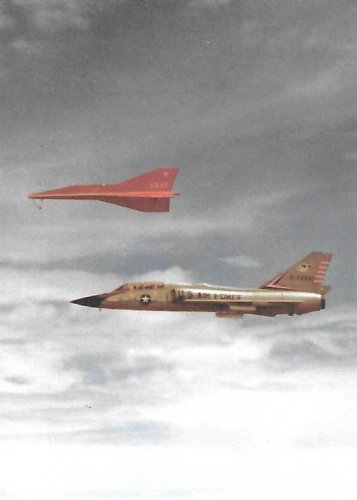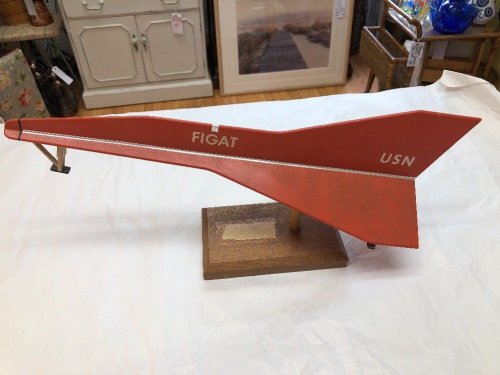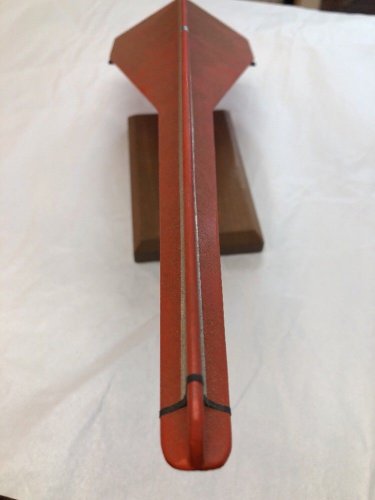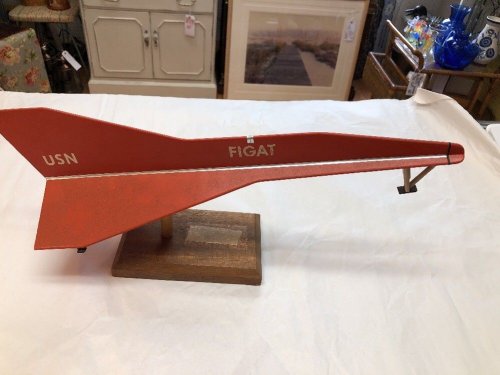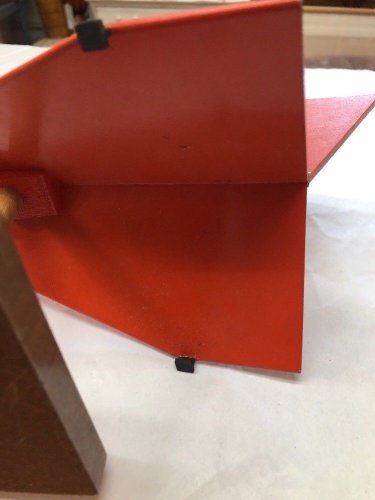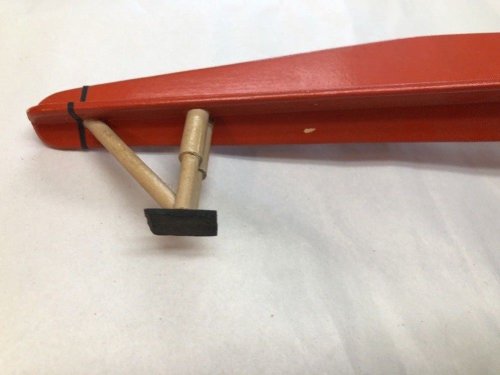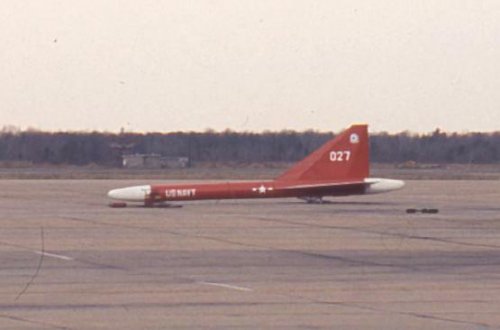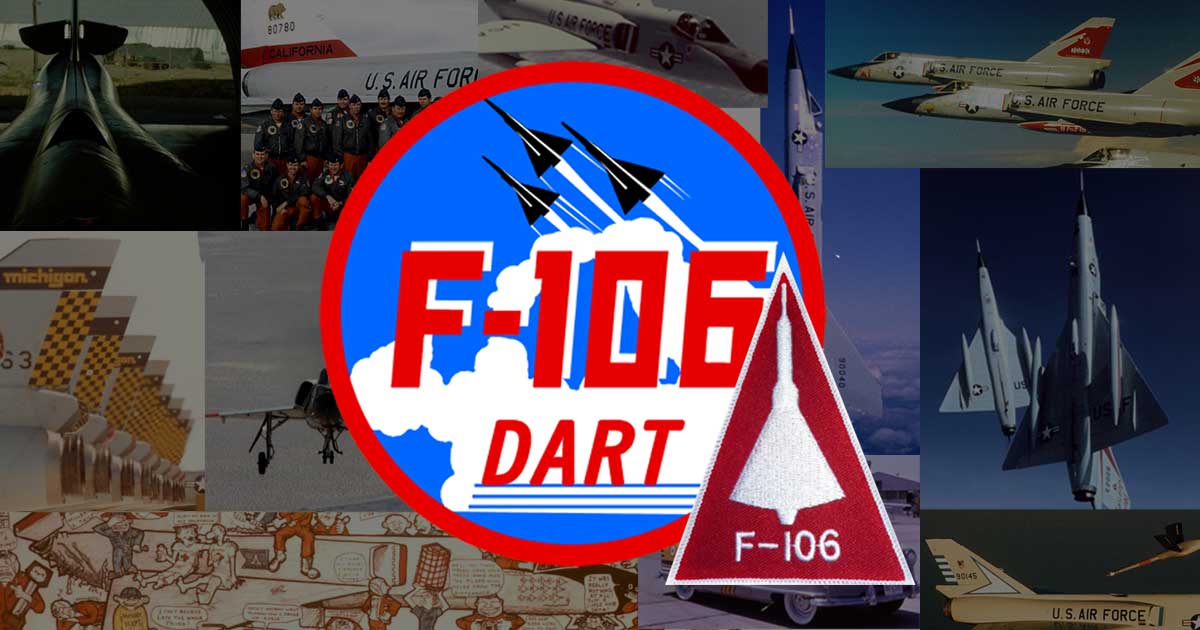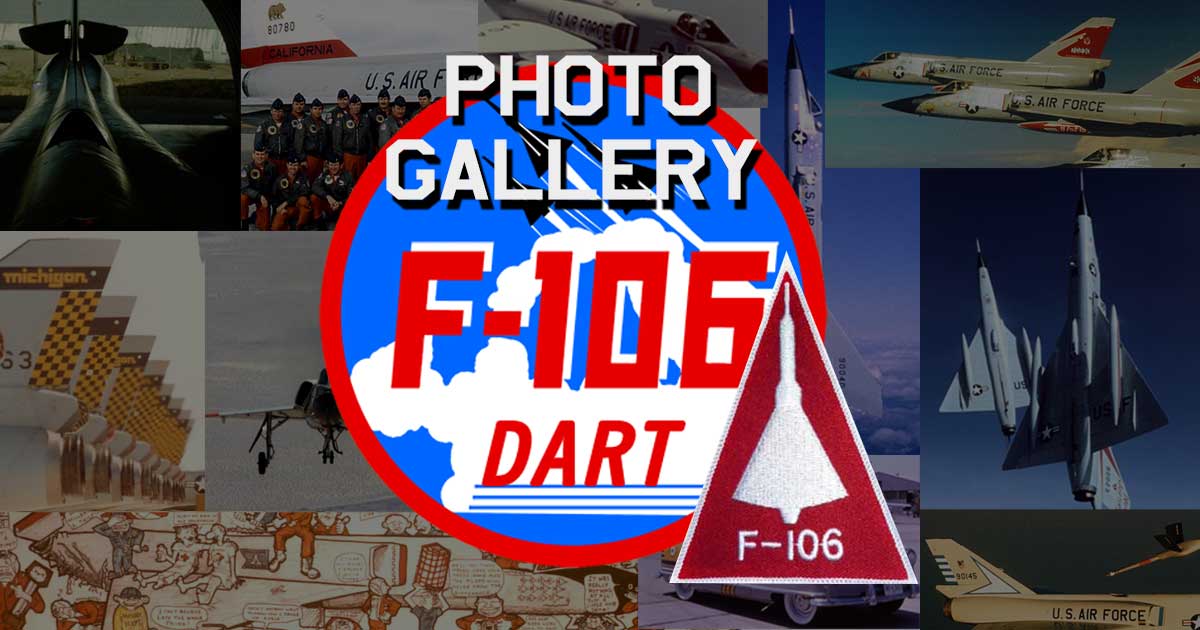- Joined
- 25 June 2009
- Messages
- 13,745
- Reaction score
- 2,928
I recently happened on a photo of a U.S. Navy tow target which I hadn't previously seen.
Linked from the VC-2 squadron page of the A-4 Skyhawk Association website, it was accompanied by no explanatory text, only a short caption saying "1974: Ed Jennings tells us about the "FIGAT". As I was curious to know more about FIGAT, I looked for it on the web, but found very little... and what I found was definitely NOT the target in the photo.
FIGAT (which stood for FIberGlass Aerial Target) was a "large profile fighter tow target" of very simple configuration, with flat surfaces, drooping cropped delta wings and a rudimentary nose skid. The FIGAT was extensively used in air-to-air gunnery practice by both the Air Force and the Navy. It was first used in ground-to-air gunnery tests by the Army during the GADES project. The FIGAT was dart-shaped, 30 feet in length, weighed 500 pounds, and had a nominal broadside area of 105 square feet. The FIGAT demonstrated tow speeds to Mach 0.9 (approximately 600 knots) and maneuvers to 4.5 g. An F-4 Phantom jet aircraft was the tow craft during the GADES test.
Other remarks gleaned from my search:
[list type=decimal]
[*]One source claims the FIGAT was only eight-foot long, perhaps indicating there came in different sizes (he could also have made a mistake).
[*]FIGAT targets were typically towed by F-101 Voodoos and TA-4 Skyhawks.
[*]They were used for live firing and gun sight tests.
[*]They provided a large profile available with a scoring system, but proved costly with a demonstrated low rate of survival.
[/list]
Documents mentioning the FIGAT:
Detailed analysis performed to appraise the flight worthiness of a tow target system installed on the Navy A-4 airplane.
The system consists of a Modified RMU-8/A installed on the centerline Aero 7A bomb rack, controlled by a panel mounted in the left hand console in the cockpit (forward cockpit of "T" models of the A-4), 0.182 inch-diameter 3x7 cable towline (10,800 feet stored on the reel-launcher spool) and a large profile fighter tow target such as the "FIGAT".The reel-launcher is installed on the centerline mounted AERO 7A bomb rack of the A-4.
http://www.dtic.mil/dtic/tr/fulltext/u2/787059.pdf
Air-to-Air Gunnery
Selection of the tow target is of primary importance in conducting air-to-air gunnery evaluation. The target should have maneuver capability consistent with the test aircraft firing envelope to allow evaluation under demanding attack profiles. A scoring system is almost a "must" for reasonable recording of hits or near misses. Dart towed targets and towed banners may be used as nonscorable targets. The FIGAT fiberglass tow target provides a large profile available with a scoring system, but is costly with a demonstrated low rate of survival. (...) Targets may be flown in standard racetrack, butterfly, or combat Dart patterns depending on desired shooter firing conditions.
Tests should begin with benign low range, load factor, and angle off conditions and proceed to more demanding target/shooter ranges and geometeries to fully evaluate system capability. Analysis of HUD film will reveal target tracking capability and firing opportunity durations. Hits per pass or passes on which hits are made are recorded to provide comparisons with earlier results and some measure of system operational effectiveness.
Pilot evaluation forms a very important part of this test phase covering aircraft handling and tracking characteristics, HUD display clarity, utility and overall comparison of gunsight effectiveness with other systems.
From AGARD LECTURE SERIES No. 108: Aircraft Assessment and Acceptance Testing
http://www.dtic.mil/dtic/tr/fulltext/u2/a088530.pdf
1974: Ed Jennings tells us about the "FIGAT".
May 27, 1974: Lt. Robert E. Rhode, ejected safely, was rescued and taken aboard USS Independence, after his TA-4J BuNo 158114 was accidently shot down off Jacksonville, FL. Rhode was flying a safety plane, near another craft towing an eight-foot long target device, when the unarmed Sidewinder missile fired from an A7 Corsair attack jet went astray and hit his plane.
The Lowell Sun, Tuesday, May 28, 1974.
http://a4skyhawk.info/article-unit/vc2
M61A1 GAU 4 20-MM Vulcan Cannon
Convair F-106B s/n 58-0795 was assigned to 475th Test Squadron, Tyndall AFB. It was the final test platform for the F-15 gun sight. Stewart Cranston ran the project. I believe he was a Capt. at the time and put on his oak leaf during the project. The F-15 was delivered with no gun sight because it was still being developed and tested. A FIGAT tow target pulled by the F-101, at 2000 ft behide the aircraft was the primary target used for live firing and test of the gun sight. Maj. John Mantei did the lion's share of the test flying during the development process. "795" was a chase bird and came back to Tyndall, under the PQM program, to be a target herself. She was shot down over the Gulf of Mexico.
https://www.f-106deltadart.com/weapons_20mm_cannon.htm
https://www.f-106deltadart.com/piwigo/comments.php?&start=2710
Photos attached:
So now I'm back to square one: WHAT ON EARTH was that Navy tow target in the last photo, supposed to be FIGAT but obviously something else altogether?
The name of the photo file "vc2-figat-mar74-perrine.jpg" suggests the photo was taken in March 1974 by James W. Perrine, who also took many of the other photos in that page.
Linked from the VC-2 squadron page of the A-4 Skyhawk Association website, it was accompanied by no explanatory text, only a short caption saying "1974: Ed Jennings tells us about the "FIGAT". As I was curious to know more about FIGAT, I looked for it on the web, but found very little... and what I found was definitely NOT the target in the photo.
FIGAT (which stood for FIberGlass Aerial Target) was a "large profile fighter tow target" of very simple configuration, with flat surfaces, drooping cropped delta wings and a rudimentary nose skid. The FIGAT was extensively used in air-to-air gunnery practice by both the Air Force and the Navy. It was first used in ground-to-air gunnery tests by the Army during the GADES project. The FIGAT was dart-shaped, 30 feet in length, weighed 500 pounds, and had a nominal broadside area of 105 square feet. The FIGAT demonstrated tow speeds to Mach 0.9 (approximately 600 knots) and maneuvers to 4.5 g. An F-4 Phantom jet aircraft was the tow craft during the GADES test.
Other remarks gleaned from my search:
[list type=decimal]
[*]One source claims the FIGAT was only eight-foot long, perhaps indicating there came in different sizes (he could also have made a mistake).
[*]FIGAT targets were typically towed by F-101 Voodoos and TA-4 Skyhawks.
[*]They were used for live firing and gun sight tests.
[*]They provided a large profile available with a scoring system, but proved costly with a demonstrated low rate of survival.
[/list]
Documents mentioning the FIGAT:
Detailed analysis performed to appraise the flight worthiness of a tow target system installed on the Navy A-4 airplane.
The system consists of a Modified RMU-8/A installed on the centerline Aero 7A bomb rack, controlled by a panel mounted in the left hand console in the cockpit (forward cockpit of "T" models of the A-4), 0.182 inch-diameter 3x7 cable towline (10,800 feet stored on the reel-launcher spool) and a large profile fighter tow target such as the "FIGAT".The reel-launcher is installed on the centerline mounted AERO 7A bomb rack of the A-4.
http://www.dtic.mil/dtic/tr/fulltext/u2/787059.pdf
Air-to-Air Gunnery
Selection of the tow target is of primary importance in conducting air-to-air gunnery evaluation. The target should have maneuver capability consistent with the test aircraft firing envelope to allow evaluation under demanding attack profiles. A scoring system is almost a "must" for reasonable recording of hits or near misses. Dart towed targets and towed banners may be used as nonscorable targets. The FIGAT fiberglass tow target provides a large profile available with a scoring system, but is costly with a demonstrated low rate of survival. (...) Targets may be flown in standard racetrack, butterfly, or combat Dart patterns depending on desired shooter firing conditions.
Tests should begin with benign low range, load factor, and angle off conditions and proceed to more demanding target/shooter ranges and geometeries to fully evaluate system capability. Analysis of HUD film will reveal target tracking capability and firing opportunity durations. Hits per pass or passes on which hits are made are recorded to provide comparisons with earlier results and some measure of system operational effectiveness.
Pilot evaluation forms a very important part of this test phase covering aircraft handling and tracking characteristics, HUD display clarity, utility and overall comparison of gunsight effectiveness with other systems.
From AGARD LECTURE SERIES No. 108: Aircraft Assessment and Acceptance Testing
http://www.dtic.mil/dtic/tr/fulltext/u2/a088530.pdf
1974: Ed Jennings tells us about the "FIGAT".
May 27, 1974: Lt. Robert E. Rhode, ejected safely, was rescued and taken aboard USS Independence, after his TA-4J BuNo 158114 was accidently shot down off Jacksonville, FL. Rhode was flying a safety plane, near another craft towing an eight-foot long target device, when the unarmed Sidewinder missile fired from an A7 Corsair attack jet went astray and hit his plane.
The Lowell Sun, Tuesday, May 28, 1974.
http://a4skyhawk.info/article-unit/vc2
M61A1 GAU 4 20-MM Vulcan Cannon
Convair F-106B s/n 58-0795 was assigned to 475th Test Squadron, Tyndall AFB. It was the final test platform for the F-15 gun sight. Stewart Cranston ran the project. I believe he was a Capt. at the time and put on his oak leaf during the project. The F-15 was delivered with no gun sight because it was still being developed and tested. A FIGAT tow target pulled by the F-101, at 2000 ft behide the aircraft was the primary target used for live firing and test of the gun sight. Maj. John Mantei did the lion's share of the test flying during the development process. "795" was a chase bird and came back to Tyndall, under the PQM program, to be a target herself. She was shot down over the Gulf of Mexico.
https://www.f-106deltadart.com/weapons_20mm_cannon.htm
https://www.f-106deltadart.com/piwigo/comments.php?&start=2710
Photos attached:
- 1. FIGAT Towed Target towed by an F-101, reeled out 2000ft behind the aircraft and used for a gunnery target over the Gulf of Mexico.
https://www.pinterest.com/pin/413909021989062378/ - 2-6. FIGAT Vintage USN Navy Research Aircraft Desk Top ModelFIGAT wooden desktop model in U.S. Navy guise.
https://www.ebay.ca/itm/FIGAT-Vintage-USN-Navy-Research-Aircraft-Desk-Top-Model/183280346442 - 7. Unidentified tow target of much more sophisticated design, labeled as a FIGAT (photo taken in March 1974 by James W. Perrine).
http://a4skyhawk.info/sites/default/files/images-general/vc2-figat-mar74-perrine.jpg
So now I'm back to square one: WHAT ON EARTH was that Navy tow target in the last photo, supposed to be FIGAT but obviously something else altogether?
The name of the photo file "vc2-figat-mar74-perrine.jpg" suggests the photo was taken in March 1974 by James W. Perrine, who also took many of the other photos in that page.

